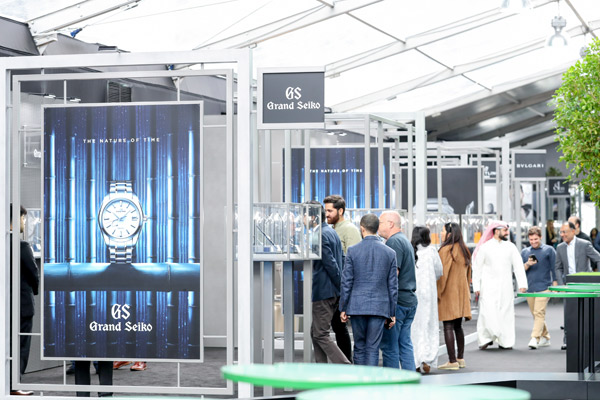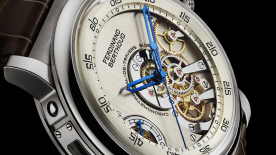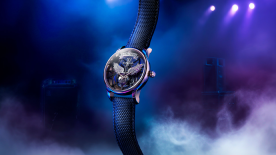In four editions, Dubai Watch Week has grown from a regional watch exhibition with mainly local market involvement to a cultural juggernaut with the support of the world’s biggest brands and an internationally exported format — the dynamic Horology Forum.
WorldTempus has been reporting on Dubai Watch Week since its early years, and there’s no doubt on our side that the event has been instrumental in shaping the evolution of watch discourse worldwide. Openness of exchange, a fearless approach to hot-button topics, and an unwavering focus on the future of watchmaking are three hallmarks of DWW activities.
These hallmarks are replicated in our in-depth conversation with Hind Seddiqi, Director General of Dubai Watch Week, Chief Marketing Officer of Seddiqi Holding and the woman who holds the formula to a new kind of fine-watchmaking discussion. In the first half of this two-part article, Hind Seddiqi reveals the secret behind the success of Dubai Watch Week and outlines the path to reaching new audiences.
We’re here on the last day of Dubai Watch Week and it’s clear that there’s something different about this event. Unlike other exhibitions and watch fairs, where people are often exhausted at the end and ready to go home, here we can observe that everyone is still energised, trying to have one last meeting, one last session, one last presentation. What’s the secret behind all of this?
That’s a very big question! It’s a mix of a lot of things. Number one — this is the charm of Dubai. I have to say, all the tourists — everyone who comes here can sense this kind of energy in Dubai that makes you want to live every second to the fullest. There is the venue of Dubai Watch Week (DWW), the Dubai International Financial Centre (DIFC), and just being in the open air with good weather (except for the first day, which was very rainy). Being around this urban architecture, there is a mood of sophistication but not in an intimidating way. There is also the energy and passion of the Seddiqi family and the Seddiqi team, I like to think it rubs off on everyone, because you can see that everyone loves what they’re doing.
The brands, the journalists and all our visitors who come here get caught up in that mood; they come here knowing that they’re going to learn something new. They’ll talk to people they don’t normally get the chance to meet, and they’ll discuss things they probably don’t get a chance to talk about elsewhere — like the kind of daring conversations that take place in the panel discussions. In the brand exhibition space, the brand representatives don’t have the stress of sales targets or activities, since DWW is not a commercial event.

What’s the criteria of success for something like Dubai Watch Week, if there are no numerical indicators like sales to act as a benchmark?
When someone asks me how we gauge the success of DWW if there is no commercial element to it, I say it depends on the people and how happy they are. It depends on how many people our participating brands spoke to at their booths, if they had good exchanges with our visitors. The ultimate question is — if we do it again, are you coming? If the answer is yes, then for us we can count DWW a success. We know as well that this year, we were able to attract more members of the public, due to the way we designed the event, with attractive F&B elements. The purpose was to break the ice, to change the mindset of watch exhibitions being boring, of people thinking to themselves, “I don’t know anything about watches, why would I go”. We already have feedback from the public about how much they enjoyed their time here, even if they never even felt comfortable coming to this area before — because they thought it was a business area. Now they know it’s more than that. We also know that traffic is better than the 2017 edition of DWW, thanks to the DWW app that comes with a badge that is scanned when registered visitors attend activities. Because of this, and also from the feedback that we’ve received from brands, we know for sure we had people coming who had never been to DWW before.

One of the big topics at DWW this year was sustainability. There was a talk focused on this and one of the brand booths (Chopard) had a strong theme of ecological responsibility. A lot of people would say that luxury and eco-sustainability are not really compatible topics, but here you seem to say that you can have both — you don’t have to choose between them.
We wanted Dubai Watch Week to be strongly about sustainability, and to be very honest, we had a bit of resistance from some brands initially. As someone who’s in marketing, I understand where they’re coming from, because once you use a word like “sustainable”, you have to make sure you really are sustainable, from A to Z. The message has to be clear all the way. If I can’t be 100 percent sure that the brands are going in that direction, then we can’t claim to be sustainable.
In terms of the DWW logistics and organisation, however, I can say that the Seddiqi values are against any kind of unnecessary waste. Whatever we can build or rent, we do that, because we don’t want anything to go to waste. After the event, we store what we can, we reuse what we can, and we work with a charity that repurposes some of our structures to furnish homes and schools. We’ve been doing this for as long as DWW has taken place. We don’t throw anything away, it’s against our values to do so. We host a lot of events through Ahmed Seddiqi & Sons, so many of the things you see at the exhibition, like the towers and displays, will be reused, either by us or by partner brands who have upcoming events.
Is it easy convincing people that sustainability needs to become a high priority for them?
We were talking to some of the brands about not bringing paper catalogues, because in past years they would come with a lot of catalogues, which would not be completely distributed by the end of the week. Then they would leave and not take the catalogues back with them, creating a lot of wastage that way. We suggested bringing much fewer catalogues — our visitors don’t want to go around carrying heavy bags of brand catalogues anyway — and create a digital version that can be downloaded by scanning a QR code. It was difficult to persuade some people at first, but we hope that we’ve planted a seed and that they will do something about it next time. When I see this kind of resistance sometimes, it worries me, because this is where the youth is going, and if you don’t address the issues that are important to them, they will forget you. The industry as a whole needs to start realising this. You need young people on your team to know what they are thinking, and you need them on your side — not just for show, but in a meaningful way. I think we’ll see things change much more quickly when there are more young people in the industry.
What’s the biggest misconception that people still have about Dubai Watch Week?
You mean with the general public? I saw these memes going around on social media about Dubai Watch Week. People were joking about coming to DWW and pretending to know about watches or getting a peek at the lives of rich people. There is this idea of, “We can’t go to DWW, or we don’t belong there, because we don’t have enough money” — and that’s not true. As much as we tell people that there is no commercial angle, they still feel like there will be someone there trying to sell things to them. So there is that.
Also, there are people who still don’t believe that we, Ahmed Seddiqi & Sons, are doing this because we are passionate about watchmaking and we want to do something that gives back to the industry. I still get asked, what’s the hidden agenda? There is no hidden agenda, which is apparently quite difficult for some people to believe. What you see is what you get at Dubai Watch Week; we’re really investing a lot of money to build this space, and we’re doing it to create an environment for watchmakers and people who are interested in the industry to come and talk, share knowledge and appreciate the craft. In a way, I don’t blame them because we’ve become a world of cynics, but I want to ask the sceptics to come and see, to be open, and then maybe you can believe in what we’re doing here. You might be surprised. If there’s something you think we’re doing wrong, talk to us, we’re listening. Tell us, give us ideas, and we’ll work on it if it’s feasible and linked to our mandate.
There seems to be this mindset when it comes to watches — if I can’t afford it, it doesn’t interest me. You don’t see this in art, cars or fashion. People are comfortable visiting museums and galleries that showcase priceless works of art, they love watching programmes about supercars worth millions, they tune in to watch Fashion Week runway shows featuring extravagant creations. How can we change this?
It’s also significant that when people from the watch industry create content, it tends to be quite heavy for people who don’t know or understand technical terms. I think people like WatchBox Studios are making that side of things a little more fun and easy. Even if you don’t know anything about watches, you can just watch one of their videos and you will learn something. It’s not presented like a press release — that doesn’t work anymore, so if you want to remain intimidating to new audiences, keep doing what you’re doing. If you want to break that ice and you want people to feel welcome, just be more flexible in the way you explain things. Those who are doing great in this area are the independent brands; they have that passion for doing things in a different way. We need change and we can’t do it alone, we have to do it collectively.
Watch out for the second half of our interview, where Hind Seddiqi goes into detail about how to speak to three demographics that have eluded mainstream brands and retailers so far — the youth, women and the secondary market.




